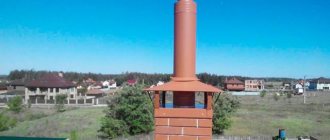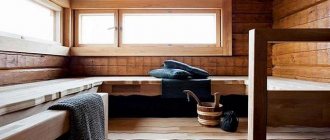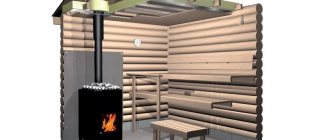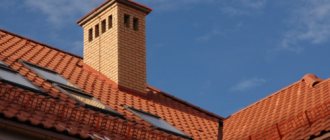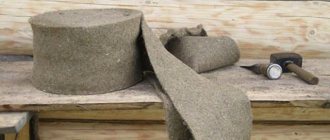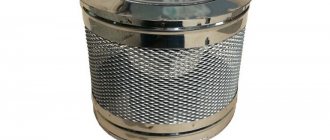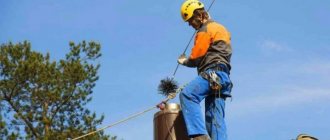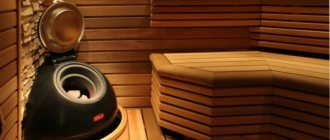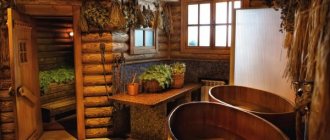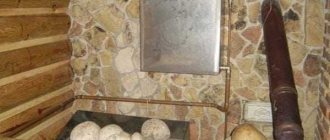Causes of condensation in a stove chimney.
It is believed that for normal operation of a brick stove, the smoke at the exit from the stove into the chimney must have a temperature of at least 250 degrees Celsius.
At this temperature of the flue gases at the entrance to the chimney, at the upper end of the pipe there will be a temperature of about 105 degrees Celsius. (with a well-designed chimney)
This temperature regime allows you to avoid condensation of the chimney.
Wood stove design
Despite the fairly wide variety of models (cast iron, brick), almost all wood-burning stoves have the same design elements:
- Foundation or foundation. A necessary element when installing any stove. Its main purpose is to prevent deformation of the soil or floor surface under the stove.
- Frame. Can be lined with brick or made of cast iron.
- Combustion chamber. The space in which combustible material is converted into heat.
- Ash pit. From the name it becomes clear that the resulting ash and ash fall into the ash pan.
- Kamenka. More complex designs of sauna stoves include a heater - a space inside the stove filled with stones to produce dry steam. .
- Chimney. System for removing smoke from the room. Chimney design is a very important part of installing a wood stove. An incorrectly installed chimney can lead to disastrous consequences when heating a room with a stove. We will talk in detail about the design of a wood stove chimney, its installation and operating rules in this article.
More detailed information about the design and types of wood-burning stoves can be found on our website. Anyone interested in purchasing their own heating boiler should read it.
The sandwich chimney is heating up. Causes.
Heating the outer contour of a sandwich chimney is a natural physical process. To understand whether a working chimney poses a danger, you need to know the normal and permissible temperatures. Below is a calculated table of temperatures of the external chimney circuit. All values are given for typical insulated sandwich pipe diameters of 50 and 100 mm. Potentially dangerous temperatures for chimneys are indicated in red.
The following reasons can lead to dangerous heating of the external chimney circuit:
1. Thin steel inner tube. For solid fuel units (stoves, fireplaces, boilers), it is recommended to install a sandwich pipe with an internal contour with a thickness of 0.8 mm.
2. Thin thermal insulation of sandwich pipe. The thickness of the sandwich chimney insulation for solid fuel units (stoves, fireplaces, boilers) must be at least 50 mm, for sauna stoves - 100 mm.
3. Settlement or displacement of the heat insulator in the sandwich pipe as a result of improper installation and operation. To avoid this situation, use only sandwich pipes with non-shrink insulation technology.
4. Installation of a bottom plug with an insert (or a structurally similar element) when transitioning from a non-insulated pipe to a sandwich. The use of such an element is not recommended by manufacturers, because leads to direct heat transfer from the inner pipe to the outer circuit. For solid fuel units (stoves, fireplaces, boilers), it is recommended to use a lower end cap.
Chimneys of wood stoves: purpose and operation
What is a standard smoke exhaust system? The chimney (for wood-burning stoves, including) is a vertically installed channel in the form of a pipe, the purpose of which is to remove all products formed during the combustion process to the street.
A variety of materials are used to make chimneys, from brick and metal to asbestos cement and concrete. The choice of material depends on the placement conditions, the stove model and the frequency of its use, as well as on the volume of the combustion chamber.
It should be noted that any chimney requires special care. Without attention, the chimney will quickly become clogged, lose draft and cease to fully cope with its functions. The best thing to do is to clean the pipes before the start of the season of constant operation of the furnace. A necessary procedure for caring for a chimney is checking the pipe and sleeve, as well as inspecting for cracks.
Types of systems
The design of sauna stoves includes 2 types of chimneys:
- Indigenous. They are organized next to the stove, using a special pipe for connection, through which the smoke goes into the main channel. One chimney can be used for 2-3 stoves. The main thing is that its internal diameter has the appropriate parameters, and the pipes from each heating device are located at different heights;
- Systems with a mounted pipe are mounted directly on the stove pipe and discharged through the roof. This chimney option is the most common for sauna stoves.
Classification of chimneys according to installation location includes 2 types:
- External. Their main part is located on the street and fixed to the wall using a bracket. They are not particularly recommended for baths, as they quickly cool down, losing precious heat.
- Internal. These are vertical structures with good traction, located inside the building.
Depending on the material used, chimneys are:
- Brick. A traditional look, characterized by labor-intensive masonry and high requirements for compliance with all parameters. They have a lot of advantages: durability, fire safety, strength, good thermal insulation and heat accumulation. Disadvantages include the roughness and angularity of the inner surface on which soot deposits accumulate;
- A metal chimney is faster to install and costs less. It has a perfectly smooth surface, but weaker heat-retaining characteristics;
- A combined version, including 2 parts: the lower one is made of brick, the upper one is made of a modern sandwich pipe. Allows you to organize neat, small passages that are easier to cover with heat-resistant material.
Poor draft in the chimney: consequences
A prerequisite for the proper functioning of the chimney is the presence of natural draft. Poor draft in the chimney of a wood stove will cause smoke to accumulate in the room, and air (necessary to maintain the fire) will cease to flow.
To prevent this from happening, it is necessary to take the issue of designing the chimney duct very seriously. Errors or poor-quality calculations will lead to the formation of too strong or too weak draft inside the chimney duct.
Pipe location
The chimney pipe can only be positioned vertically. The deviation from the vertical axis can be no more than 30 degrees, or 1 meter in any direction. The chimney is connected to the gas boiler in such a way that a pipe section of at least 0.5 m in length comes out of the boiler.
The number of bends and turns in the chimney should be kept to a minimum if possible. If this is not possible, then it is possible to install bends and elbows, but their total number should not exceed 3. Horizontal sections of pipes can have a slope of no more than 0.01 degrees towards the boiler.
Advantages of a wood-burning stove in a bathhouse and sauna
Installing a wood-burning stove in a bathhouse is undoubtedly a smart decision. Thanks to its features, it is not only practical, but also profitable:
- The low cost of fuel will allow you to significantly save on heating;
- Thanks to the natural heat, the steam room warms up twice as quickly as with gas;
- A wide range of wood-burning stoves will allow you to choose a design that is ideal in size and price;
Find out more about wood-burning sauna stoves, their operating features and advantages.
The chimneys of a wood-burning sauna stove have a number of design features that distinguish them from standard smoke exhaust systems. The most important thing is to make sure that carbon monoxide does not penetrate into the steam room, and soot does not settle on the walls of your bathhouse.
Asbestos cement pipes - the generosity of the USSR
Asbestos-cement pipes have been widely used since the times of the USSR. Why? Yes, they were cheap, easy to produce, and there was plenty of natural asbestos in the country. Moreover, such pipes could be used without any preliminary insulation for a wide variety of agricultural needs. But they were never intended for arranging chimneys.
But the need for invention is cunning, as they say. The times of reclamation have sunk into oblivion, but asbestos-cement pipes remain. And during the period of mass construction of private houses, they came into use as chimneys. Many opponents of this implementation immediately appeared - first of all, environmentalists who argued that asbestos cement releases many bad compounds into the environment. Although, according to scientists, asphalt on the road is even more carcinogenic. But, nevertheless, even the roofs of buildings today are covered with a variety of expensive roofings instead of cheap and durable asbestos.
And yet, all these fears and myths have little to do with chimneys made from asbestos-cement pipes. And at the same time, they are not at all safe - this material was never designed for high temperatures, and can ignite at 300˚C. Therefore, if you are placing them, then not at the stove itself - but as close as possible to the roof, where the smoke is already a little cooled.
But there is also a second point. Soot forms in any chimney, but the smoother the walls, the less it lingers on them. But asbestos-cement pipes have never been smooth, and a lot of soot accumulates on them. And it’s easy for it to catch fire – any stove maker knows this. Moreover, if the soot ignites inside the asbestos-cement pipe, it will simply explode! Can you imagine the consequences?
And asbestos-cement pipes are severely destroyed by condensation. How can this be if they were originally intended for water? That's right - for water, and condensate is an aggressive environment from a mixture of combustion oxides and a very small amount of moisture. Moreover, the oxides also contain a good percentage of hydrochloric acid, which even destroys bricks, but asbestos also absorbs what it can, transferring all this to the building in the form of unsightly stains with the same unpleasant odor.
Bottom line: we decided to take a risk and use a free asbestos-cement pipe for the chimney - be sure to clean it, and as often as possible. True, you will also struggle with this - you won’t be able to make inspection windows in such pipes.
Chimneys for a bathhouse: internal or external?
All chimneys of wood-burning stoves for baths are usually divided according to the principle of their installation into internal and external. In Russia, internal systems are more popular. They allow you to significantly save heat indoors, while external ones are more typical of Western-style baths and have more of an aesthetic function.
Each of the models has a number of advantages and disadvantages:
- Interior. It is distinguished by increased internal draft, significantly exceeding the draft of the external chimney. When installing it, there is no need for additional insulation and the presence of a door for cleaning the pipe from soot. In general, caring for it is much simpler than external care and requires almost no significant action. Another advantage is the fact that the internal chimney retains heat inside the room for a long time. The only drawback is the complex design.
- External. When installing it, you will not have to make holes in the walls and roof, however, the natural draft of such a chimney is much lower. In general, as already mentioned, its installation is more of an aesthetic nature.
Advantages and disadvantages
Like any device, pipes of this type have their pros and cons. They have few disadvantages, but they are important:
- considerable price for the components of the structure;
- relatively short service life;
- gradual loss of tightness due to temperature changes.
The advantages of chimneys with sandwich-type pipes are as follows:
- Easy and clear installation. This distinguishes such smoke exhaust systems from devices whose installation requires calling a specialist.
- Small pipe sizes.
- The versatility of chimney pipes can go both into the walls and into the ceiling.
- Many layers that prevent condensation from accumulating on the pipes and serve as protection against the appearance of soot.
- This chimney is not afraid of the effects of chemicals and aggressive environments that appear during their use.
- Fire safety. Such chimneys are currently considered the best in terms of this parameter.
Chimney installation: calculation and main mistakes
When installing a smoke exhaust system, it is very important to correctly calculate the chimney for a wood-burning stove. Any errors that are made during the calculation process will affect its work in the future.
When calculating the chimneys of wood-burning stoves, we pay attention to two indicators - the height and diameter of the pipe section. We will talk about the section and its types later, first we will deal with the height.
When calculating the optimal height of the structure, it should be understood that the chimney must maintain natural draft. The chimney should not be too high (despite the fact that in a high chimney the draft will increase, too much cold air will flow inside). However, you can’t make it too low, in which case you risk losing traction altogether.
Calculating the height of a chimney is a complex operation that is best left to a professional. However, if you decide to do it yourself, then remember two things:
- Pipe diameter and height are directly related and vary depending on each other;
- In general, the height of the chimney above the roof level cannot be less than 500 mm.
When does firewood produce more heat?
To organize economical heating of a private home, you need to extract maximum thermal energy from wood, and then transfer it to the premises with minimal losses. The second condition depends on the efficiency of the heat source, but the first one depends precisely on the temperature of burning wood in the furnace or boiler. The higher it is, the more heat is released.
The amount of heat generated when wood burns (heat output) is influenced by the following factors:
- caloric content (the amount of thermal energy that can be obtained from a unit of fuel);
- natural moisture content in wood;
- volume of supplied air and its temperature.
In practice, all of the above parameters are interconnected. The calorie content of fuel supersaturated with moisture is approximately 2 times lower than that of dry wood. And without the required volume of air, it will begin to smolder and emit minimal heat. That is, the real combustion temperature of wood is not a constant value and cannot be accurately indicated in theoretical considerations.
For reference. There is a simple way to determine what fire temperature is reached when burning wood in an open firebox. Use an infrared pyrometer that measures the heating of surfaces from a distance, as the master stove maker did in his video. It demonstrates testing of a barbecue fireplace insert; measurements are taken in the second half of the video.
Now let's look at each factor separately.
About the calorific value of fuel
Different types of wood differ in density and weight, and also contain different amounts of carbon and hydrogen - the main components that produce heat during the combustion process. As a rule, denser and heavier species, such as oak and ash, provide more energy than poplar or alder. We present to your attention a table with data on the density, specific heat and combustion temperature of various types of wood.
Note. The table shows the values of the mass and volumetric heat of combustion of dry fuel per 1 kg and per 1 m³ of storage. The maximum temperature is based on ideal combustion conditions with excess air.
If we compare the calorific value by volume, it is noticeable that oak or birch logs will emit more heat than less dense coniferous species. And although the conditions for burning wood in a stove, potbelly stove or boiler are far from ideal, the trend will still persist. That is, the flame temperature directly depends on the calorific value of the selected wood species.
Chimney material: brick and metal
So, what types of wood stove chimney are there and how do they differ? First of all, it should be said that the design of the chimney depends on the material from which it is made:
- Brick. The use of brick necessitates the construction of a serious foundation and the absence of plaster inside the pipe itself (reason: condensation in the chimney pipe of a wood-burning stove).
- Metal. Pipes made of stainless metals are a system of modules, each of which is represented by a separate element. Stainless steel is much better suited for a chimney, due to the fact that it is not susceptible to condensation and soot. There are also double-walled stainless steel pipe models with built-in insulation.
Great Encyclopedia of Oil and Gas
Page 3
The temperature of the flue gases at the furnace outlet must be at least 150 C higher than the initial temperature of the heated raw material in order to prevent intense corrosive wear of the pipe surfaces in the convection chamber. [31]
The temperature of the flue gases at the outlet of the boiler, the temperature of the heated air at the entrance to the furnace, the flow and thermodynamic parameters of superheated and intermediate steam, and feed water for a given load factor are considered unchanged. [32]
The temperature of the flue gases above the pass wall is especially important. The high temperature of gases at the pass corresponds to high thermal stress on the surface of the radiant tubes, the temperature of their walls and a high probability of coke formation. Being deposited on the inner surface of the pipes, coke impedes heat transfer, which leads to a further increase in the temperature of the walls and to their burnout. [33]
The temperature of the flue gases in front of the recuperator in heating furnaces reaches 1400 C. [34]
The temperature of the flue gases entering the chimney must be maintained no higher than 500 C by regulating the flow of cooling air supplied to the flue by a fan. [35]
The temperature of the flue gases at the inlet to the heat exchanger of the starting heater should not exceed 630 - 650 C. Exceeding this temperature can lead to its premature failure. It is even more important that when the starting heater is operating, air or gas is always supplied to the annulus of the heat exchanger. When air or gas is turned off, the temperature of the tube sheets and pipes rises sharply and the heat exchanger may fail. In this case, it is necessary to immediately reduce the temperature of the flue gases to 450 C. [36]
The temperature of the flue gases at the entrance to the second chamber is maintained at 850 C. The gases leaving this chamber with a temperature of 200 - 250 C enter the first (along the acid) chamber, where their temperature drops to 90 - 135 C. [37]
The temperature of the flue gases leaving the convection chamber and going into the chimney depends on the temperature of the raw materials entering the furnace and exceeds it by 100 - 150 C. However, when the temperature of the raw materials is high for technological reasons (furnaces for heating fuel oil, catalytic reforming furnaces, etc. ), flue gases are cooled using their heat in a steam reheater, air preheater or for reheating condensate water and producing water vapor. [38]
The temperature of the flue gases above the pass wall is one of the most important indicators. The high temperature of the flue gases above the pass wall corresponds to the high thermal intensity of the radiant pipes, the high temperature of their walls and the likelihood of coke deposits in the furnace pipes, and, consequently, the possibility of their burning out. The high speed of the heated flow of raw materials allows for greater heat removal, lowering the temperature of the pipe walls and, thus, working with a higher temperature of gases above the pass and the thermal stress of the radiant pipes. Increasing the surface of the radiant pipes also helps to reduce their thermal intensity and reduce the temperature of the flue gases above the pass. The cleanliness of the inner surface of the coil pipes is also the most important factor affecting the temperature of the gases above the pass wall. The temperature of gases above the pass is carefully controlled and usually does not exceed 850 - 900 C. [39]
| Diagram of a radiation-convective gas heater. [40] |
The temperature of the flue gases at the entrance to the radiation zone is 1100 - 1200 C, at the entrance to the convective zone 800 - 850 C. [41]
| Heat balance of gasification of petroleum distillate in a tube furnace. [42] |
The temperature of the flue gases at the outlet of the tube furnace is 900 C. [43]
The flue gas temperature in front of the recuperator will be approximately 1100 C. [44]
Pages: 1 2 3 4
www.ngpedia.ru
Calculation of diameter and optimal cross-section
Calculating the diameter of the chimney for a wood-burning stove is a key point on which the further functioning of the entire system depends. Like height, diameter affects the strength of natural draft and the temperature in the chimney. To avoid mistakes, it would be smartest to use a special table for the ratio of diameter and height.
When calculating, it is important to remember: the most optimal cross-section of the chimney is a cylinder. It provides sufficient traction force and allows you to cope with the problem of uneven heating of the channel walls.
Gas boilers
Most often, gas boilers are used to heat private houses. Their popularity is due to the affordable price of fuel and its high efficiency. Leading companies from Russia and Europe produce high-performance boilers. The temperature in the chimney of gas boilers with high efficiency usually does not exceed 80-100 degrees
, and in most cases even lower.
The combustion process of natural gas in its most simplified form is described by the formula CH4 + 2O2 = CO2 + 2H2O (complete combustion of methane). That is, from two molecules of oxygen and one molecule of methane, one molecule of carbon dioxide and two molecules of water are formed. When 1 cubic meter of gas is burned, an average of 2 liters of liquid is released. This water reacts with the oxides contained in the smoke and forms a set of acids. Since the temperature of the exhaust gases is low (all thermal energy is spent on heating water in the heating system), the dew point is located inside the chimney pipe. In this regard, condensation settles on the walls.
For gas boilers, pipes with high corrosion resistance should be selected. For example, traditional brick structures will not last long in such conditions. Moisture will penetrate microcracks and seams between bricks, which will ultimately lead to destruction of the material, and temperature changes will only accelerate this process. In addition, the condensate contains nitric, sulfuric and other acids, and therefore is highly aggressive.
Since the temperature in the chimney of a gas boiler affects the formation of condensation and service life, it is necessary to pay close attention to the inner surface of the passages. Most people install chimneys from stainless steel pipes. In general, the solution is not bad, but their service life is short, since aggressive acids can destroy even alloy steel. A ceramic pipe may be a more reliable option. It has excellent corrosion resistance, but is much more expensive. Among modern materials, plastic chimneys are gaining popularity, which are also not afraid of condensation. But before installing plastic pipes, make sure that the boiler manufacturer does not exclude this possibility. They are designed only for low exhaust gas temperatures.
If the gas boiler is planned to be connected to an existing brick system, then it is necessary to sleeve it. For lining you need to use moisture-resistant material. This can be a stainless or ceramic pipe. A polymer sleeve would be an excellent option, as it is suitable for structures of any complexity and size.
Condensation Formation
Condensation in the chimney pipe of a wood stove is a problem that any owner will face sooner or later. Regardless of the type of furnace, condensation, one way or another, will begin to accumulate inside the channel and interfere with proper operation. To combat this, a condensate drain is used, which allows you to almost completely forget about this problem.
There are also preventive ways to deal with settling condensate. For example, use only high-quality dry fuel or significantly insulate the pipe.
Normal temperature of gases leaving the furnace
In order for the water present in hot gases to evaporate better, the temperature of the latter must be increased. On well-heated pipe walls, settled drops of moisture quickly evaporate.
The normal temperature of gases leaving the furnace before exiting into the pipe is 12O...14O°C, when leaving the pipe into the atmosphere - not lower than 100°C.
If the flue gases, when exiting into the chimney, that is, at the view, reach a temperature of about 250 ° C, then condensation does not form, draft improves, the stoves heat up faster, while consuming less fuel.
The temperature of the exhaust gases can be determined using a dry splinter, which is placed across the view hole during combustion. If after 30...40 minutes you remove the splinter and scrape off the sooty surface from it with a knife, you can set the temperature of the gases. The color of the splinter does not change at temperatures up to 150°C. If the torch turns yellow (to the color of a white bread crust), it means the temperature has reached 200°C;
Thus, when firing the furnace, the temperature of the gases must be adjusted so that at the viewer it is within 250°C.
Chimneys for long-burning stoves
A long-burning stove is a necessity dictated by the harsh conditions of the northern regions of Russia. Its distinctive features include significant fuel economy and safety. However, chimneys for long-burning stoves also have their own nuances.
Firstly, when assembling a chimney for a long-burning stove, it would be wise to place the pipes in the opposite order from the gas movement. Thanks to this trick, you will get rid of the problem of resin condensation that leaks out when burning wood.
Secondly, make sure that there is good access to the chimney, and that its individual parts are secured with self-tapping screws. This way, you can disassemble it and clean the soot that has formed inside.
Thirdly, remember that 120 mm chimneys for long-burning stoves are the best option.
Which pipe is best for a sauna stove?
If you build a full-fledged steam room, then it is best to use ceramic or brick chimneys for a bath.
Stainless steel chimney for sauna stove
The metal channel is advantageous in that, regardless of the type of bathhouse, the structure does not rust from condensation and moisture. The beautiful nickel-plated surface organically complements the interior of the room, decorated with wood. The price for a sandwich is about $10 per meter. The chimney itself is made up of separate sections connected by clamps, which also secure the pipe to the wall.
Important! From ready-made parts, you can assemble a pipe of the most complex shape, bend and tilt it in an almost arbitrary manner. This means that the stove in the bathhouse can be placed in any place where the strength elements of the roof do not interfere.. A stainless steel chimney is better suited for a small bathhouse
A stainless steel chimney is better suited for a small bathhouse
In addition, the metal warms up faster, which means that draft will appear in the furnace, and accordingly, the time to warm up the steam room will be halved.
This is where the advantages of using a steel pipe for a stove end; then there are only disappointments:
- Hot metal in the humid atmosphere of a bathhouse is susceptible to gas corrosion. This means that in a year or two, depending on the intensity of use of the steam room, fistulas will appear in the chimney, and some sections will need to be replaced;
- When heated, stainless steel emits a specific “metallic” smell, which is very difficult to remove from the steam room;
- There are a huge number of fakes on the metal chimney market.
Most often, sellers boast that the sandwich body does not rot even in sea water, and the internal flame tube is made of stainless steel with a high nickel content. In fact, the outer part is made of galvanized, and the inner part is made of food-grade stainless steel. As a result, zinc vapor appears in the air of the steam room and the entire bath, which can easily be poisoned. A heat-resistant metal with a high content of silicon and manganese should be used for the inner pipe.
Brick chimney in a bathhouse
It is difficult to build a pipe out of brick. Moreover, the chimney will need to be built together with the stove, and before work begins, a foundation will need to be made. Otherwise, the slightest deviation from the vertical can cause cracks in the masonry.
You can't do without a foundation
It takes a long time to build a chimney; a full-fledged chimney using good bricks and masonry mortar can be built in no faster than a week. In this case, you will have to wait the same amount of time until the solution sets and the structure gives the planned shrinkage. The standard pipe cross-section is 10x12 cm and 15x15 cm; in practice, preference is given to a larger size due to the possible overgrowing of the surface with soot.
Brick is considered the safest option for arranging a passage through floors. Sometimes a casing for a metal pipe is even made from brick; this guarantees protection of the wooden ceiling and no burns through the wood, which often happens with metal structures.
Brick passage for stainless steel pipe
Ceramic chimney for a bath
The most progressive and convenient option for making a chimney pipe. We can say that this is the best thing you can do with your own hands without having the qualifications of a stove maker. The range of ceramic diameters is quite large, from 14 cm to 30 cm, it is clear that for an ordinary home steam room the diameter of the pipe for the stove in the bathhouse is taken to be minimal.
Sections 500 mm high
The chimney is assembled from sections cast from special heat-resistant clay and fired in a kiln at 1100°C. A ceramic chimney is not afraid of moisture, like a brick, does not rot or burn out, like metal, and at the same time has a relatively low weight.
Significant disadvantages include:
- High price for sections and components;
- The need for certain qualifications and knowledge for proper assembly.
The ceramic pipe has a low coefficient of thermal expansion, so there are no problems with shrinkage and breakage of the apron covering the pipe body on the roof. The ceramic chimney technology itself involves installing a channel inside a brick casing. To reduce losses and overheating, the ceramic channel must be sealed with basalt cloth.
Ceramics is almost no different from metal
An interesting solution is to install a chimney made of two ceramic channels. Typically, this scheme is used for a large bathhouse with a huge brick stove. The ability to block one of the channels ensures quick ignition of the firebox even in extreme cold.
Chimney assembly diagram for a bathhouse
Assembly Tips
After constructing the chimney, as well as some time of use, it is important to take care of regular cleaning of the system. The most proven way to clean a chimney is to use mechanical tools.
Special brushes, weights, and in some cases a crowbar and a sledgehammer are suitable for this.
Working as a chimney sweep is a dirty job, so everything is taken out of the bathhouse in advance, the surfaces are covered with newspapers or film:
The simplest method is to use a special brush that can be used to clean the chimney. Simply insert the brush into the pipe, then gently push it upward until the resistance due to accumulated soot disappears. It should not be rotated around its axis, otherwise there is a risk that it will get stuck in the pipe and will have to be removed in parts. Another effective method of cleaning a chimney is burning aspen wood. The method will help with a small amount of soot on the surface of the pipe. When burning aspen logs, a better traction force is created, which is capable of removing soot from the chimney.
- Potato skins have similar properties. But to prepare the required amount of material, you will have to get serious about cleaning more than one kilogram of vegetables.
- Modern methods of protecting pipes from soot using chemicals have become common in use. Modern preparations include special components that, when burned, carry away soot. The components can act as a soot separator; as a result, it will fall off the pipe walls itself.
It is believed that the best time to clean a chimney is after rain. In a humid environment it is easier to maintain the pipe. Timely cleaning of pipes will be the key to high-quality combustion of firewood. This will keep the bath warm. To learn how to make the right chimney for a bathhouse, watch the video below.
First, about brick structures, which are a continuation of the furnace masonry. The passage unit, called cutting, is performed by expanding the masonry to standard dimensions, as shown in the diagram above. It turns out that when crossing the ceiling, it is necessary to maintain a wall thickness of one and a half bricks (380 mm), and a roofing thickness of 1 brick (250 mm).
Steel pipes for exhaust gases are usually assembled from sections inserted one into the other. Moreover, the chimney must be installed in such a way that the condensate inside the flue can flow down without hindrance. That is, the upper section is inserted into the lower one, this is called a “condensate” assembly. As for modular sandwiches, the inner pipe of the inserted upper section should fit into the lower one, and the outer one should wrap around the casing of the lower one from the outside. In this way, sediments are removed and quietly flow to the ground.
- Be sure to use a ceiling passage box, even if you are using a sandwich. Fill it with expanded clay, foam glass or mineral wool. Do not fill the space around the pipe with earth, especially sand. Sand tends to get very hot and retain heat for a long time.
- The most optimal chimney height is 4.5-5 meters. Try to stick to these parameters.
- The upper edge of the pipe should rise above the ridge by at least 50 centimeters. But, if the roof is flat, then the height here should be at least a meter. For large chimney heights, special guy wires are installed.
- In a steam room, if the pipe passes near a wall or partition, then a protective screen must be installed on the wall. It can be in the form of stainless steel or basalt cardboard.
- When installing a flash drive, it is recommended to use a special thermal and weather-resistant sealant. He copes well with the task assigned to him. By the way, during the assembly of a chimney sandwich, the same thermal sealant, and sometimes crimp clamps, are often used.
- If flammable roofing material is used, a spark arrestor is required. You can do it yourself by using a used KAMAZ air filter.
- Try to avoid sandwich pipe joints in the ceiling passage. At this point the smoke channel must be solid.
We invite you to familiarize yourself with: Ventilation in the bathhouse diagram and device
Wisdom Quote: If you want the world to change, be the change.
Installation of external metal chimney structures
If the chimney installation scheme provides for its external placement, the pipe coming from the heating unit is laid through the wall of the building. To ensure the safety of the operation process, experts advise laying brickwork, which will insulate the wall when the chimney is brought out through it.
To turn the pipe in the direction of the wall, you will need a product such as a bend or elbow. These structural elements have bends at an angle of 45 or 90 degrees. They are selected taking into account the installation diagram of the smoke exhaust system.
The pipe to the stove in the bathhouse can be routed through the wall, either through a duct or through the attic floor. The box is filled with stone wool. Since there may be small gaps around the pipe, they are treated with heat-resistant sealant.
A tee is installed on the outside of the building. From here the structural elements will be installed further: upward, along the wall and to the condensate collection point located below.
Technology for cleaning a clogged chimney
And finally, it is important to take care of regular chimney cleaning. Its most proven and oldest method, for example, is mechanical
To do this, pick up brushes, special weights, and sometimes even a sledgehammer with a crowbar. True, this work is so dirty that you will have to take everything out of the bathhouse in advance and cover the remaining surfaces with layers of newspaper.
The easiest way to clean the above is with a brush - to do this, just insert it into the chimney and gently push it upward until the resistance of the accumulated soot weakens. You just don’t need to turn it, otherwise you’ll have to take out this tool in parts later.
If small growths become noticeable in the pipe, you can use aspen firewood - when it burns, it creates excellent draft, which removes the ash from the pipe. In addition, aspen has dry and intense heat, which immediately burns the resinous substances in the pipe from the coniferous firebox. By the way, potato peelings have the same properties if they can be prepared in the required quantity.
But modern methods of chimney cleaning are becoming increasingly popular - these are chemical preparations that contain special substances that can carry soot with it during combustion, or loosen it so that it falls off on its own.
The best time to clean a sauna chimney is after rain. Simple maintenance and regular care for the cleanliness of the pipes - and the firewood in the bathhouse will burn to perfection!
Regulatory requirements for the installation of chimneys
The main and only purpose of the chimney pipe is to remove waste gases from the heating boiler into the atmosphere outside the building where the stove, boiler or fireplace is installed. Moreover, the efficiency of heat-generating equipment directly depends on its correct installation.
You can install a boiler with excellent efficiency in your house, but make mistakes when installing the chimney pipe. The result is excessive fuel consumption and lack of comfortable air temperatures in the rooms. The chimney must have the correct cross-section, location, configuration and height.
If there are two boilers in the house or a stove and a fireplace in different rooms, then it is better to make separate smoke exhaust pipes for each of them. The option with one chimney is permitted by SNiPs, but only a professional stove maker can calculate it correctly.
The diameter of the chimney is selected depending on the heating equipment used. When installing the boiler, it is already specified by the manufacturer with the outlet pipe. It is prohibited to connect pipes of a smaller cross-section to it, and there is simply no need for a larger cross-section. In the second case, to increase traction, you will have to install a gearbox, which costs a lot of money.
In the case of a fireplace or Russian brick stove, everything is somewhat more complicated. Here you will have to make engineering calculations taking into account the fuel used and the size of the firebox. It is much easier to take a ready-made brick oven project that has been tested by time. Fortunately, there are many options with a clearly verified order of brickwork.
The height of the chimney pipe above the roof is determined by its distance from the roof ridge
The higher and longer the chimney, the stronger the draft. However, this can lead to overheating and destruction of its walls. Plus, a strong increase in draft is a prerequisite for the occurrence of turbulence in the chimney, which is accompanied by hum and low-frequency noise.
If the pipe is too low, the ridge can turn into an insurmountable obstacle to the smoke coming out of it. As a result, a reverse draft effect will occur with the flue gases tipping back into the firebox. How to normalize it will be discussed in this material.
During normal operation of the chimney, the horizontal wind flow, flowing around the section of the pipe above the roof, turns upward. As a result, rarefied air is formed above it, which literally “sucks” the smoke from the exhaust. However, this process can be hindered by the ridge of a pitched roof and even a tall tree in close proximity to the house.
Standards for the installation of a smoke exhaust system
Building codes require the chimney to be constructed as follows:
- Its length from the grate to the top point should be from 5 meters (an exception is possible only for buildings without attics and only in conditions of stable forced draft).
- The optimal height, taking into account all possible bends, is 5–6 m.
- The distance from the metal chimney to structures made of combustible building materials should be at least a meter.
- The horizontal outlet immediately behind the boiler should not exceed 1 m.
- When passing roofing, walls and ceilings inside the house, a channel should be constructed from non-combustible materials.
- To connect metal pipe elements, sealant should only be used that is heat-resistant with an operating temperature of 1000 °C.
- The chimney should rise at least 50 cm above the flat roof.
- If a non-brick chimney is constructed above the roof level by 1.5 meters or more, then it must be strengthened with braces and brackets.
Any slopes and horizontal sections inevitably reduce draft in the chimney pipe. If it is not possible to make it straight, then bends and displacements are best made from several inclined segments at a total angle of up to 45 degrees.
In addition to observing purely construction rules that guarantee high efficiency of the chimney and stove, it is also necessary to take care of fire safety, for which special indentations and screens are made
When installing ventilation and chimney shafts in parallel in one structure above the roof, in no case should they be covered with a common cap. The outlet from the stove must be elevated above the ventilation pipe, otherwise the draft will decrease and the smoke will begin to be sucked back into the house. The same applies to separate but adjacent hoods and chimneys.
